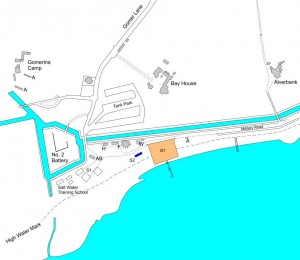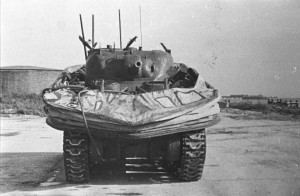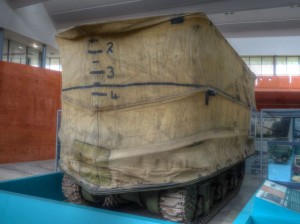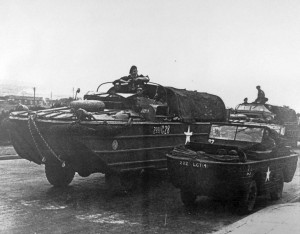79th Armoured Division.
This unit was formed specially for the D Day Normandy landings. It consisted of specially developed vehicles or ‘Hobart’s Funnies’ created to undertake special tasks on the beaches on D Day and afterwards. One of the special tanks was designated the ‘DD’ Tank or Duplex Drive tank. The Duplex Drive tank was a specially modified Valentine or Sherman tank which was able to engage a propeller to drive it through the water. A canvas screen supported on inflatable ribs could be deployed to allow the tank to sit in the water without it flooding over the top of the tank. The 79th Armoured Division was to be the spearhead of the assault on D-Day. The tanks were to be taken to the Normandy beaches by landing craft. When the craft was close in to the shore the loading ramp was to be dropped and the tanks driven off and into the water. They were then to float onto the beaches, driven by their propellers (with a top speed of 5mph) , the skirts would then be dropped and the tracks engaged. The tanks were needed on the beaches to clear away through enemy obstacles and engage enemy machine gun posts, pillboxes and artillery batteries. The 79th’s vehicles were offered to all of the forces taking part in the landings of Operation Overlord, but the Americans declined all except the amphibious Sherman DD tank. The Valentine version of the DD Tank was used for training purposes only. The Shermans were the only DD tanks to be deployed on D Day.
On D Day 176 Duplex Drive tanks were launched: 121 made it to shore. They were intended to be launched a couple of miles offshore. The Americans on Utah and Omaha stuck to the plan, despite choppy seas, and launched at two miles. At Omaha most of the DD tanks sank. Most of the DD tanks on the British and Canadian beaches were launched close to shore, because of the choppy seas, and survived.
The American sector lost 27 tanks that were probably launched too far from the beach.
From the 4/7 Dragoons all DD tanks landed on Gold beach.
From the 13/18 Hussars 34 DD tanks were launched: 33 landed safely on the beach.
After landing the tanks folded down their screen and then were used as a conventional tank. Behind them landed other tanks of Hobarts “Funnies”.

Salt Water Training School
Whilst the preparations for D Day were taking place at Stokes Bay with the construction of embarkation hards and Phoenix units, the west end of the Bay, centred around No.2 Battery, was being used from October 1943 as a section of the training school for Duplex Drive tank personnel. This section was known as the Salt Water Training School.
The Fresh Water Training School, Water Assault Wing A, was at Fritton Lake, Somerlayton in Norfolk. Initial training took place at Fritton Lake where the tank crews were given escape training, tank training and beach landing skills. The crews then came to Stokes Bay for the sea training at Water Assault Wing B. From January to May 1944 they drove their tanks onto landing craft and proceeded across the Solent towards the Isle of Wight. Approximately 1,200 yards off shore from the beach at Osborne they drove their tanks into the sea and landed on the beach. The danger point was the moment the tanks entered the water when it was possible for the waves to flood over the top of the canvas skirts. One landing craft held nine Valentine tanks or 6 Sherman tanks. Over 30,000 launches were conducted as the Duplex Drive tank training came to a close in May 1944.
 THE BRITISH ARMY IN THE UNITED KINGDOM 1939-45 |
 THE BRITISH ARMY IN THE UNITED KINGDOM 1939-45© IWM (H 35176) |
 THE BRITISH ARMY IN THE UNITED KINGDOM 1939-1945 |
 THE BRITISH ARMY IN THE UNITED KINGDOM |
 |
 PREPARATIONS FOR OPERATION OVERLORD |
 PREPARATIONS FOR OPERATION OVERLORD (THE NORMANDY LANDINGS): D-DAY 6 JUNE 1944© IWM (MH 2211) |
 TANKS AND ARMOURED FIGHTING VEHICLES |
|
 TANKS AND ARMOURED FIGHTING VEHICLES |
 TANKS AND ARMOURED FIGHTING VEHICLES |
 |
 TANKS AND ARMOURED FIGHTING VEHICLES |
The tank park was constructed at the west end of the beach close to Bay House. Workshops were built south of No.2 Battery. A testing tank was constructed on the beach nearby so that the waterproofing on the tanks could be inspected. Bay House served as the Officers’ Mess and men’s quarters with the residue quartered at Alverbank.
Various Amphibious Operations including Smash, Tiger and Fabious took place along the south coast in preparation for D-Day.
Post War Stokes Bay
After the war the Admiralty held on to No.2 Battery whilst the rest of the Bay was cleared and handed back to Gosport Borough Council. The minutes of Gosport Borough Council recorded in August 1947 Admiralty properties at Stokes Bay were to be de-requisitioned from 25 March; The War Department still requisitioned the whole area but had no objection to opening whole of Bay to the public, except the west end and No.2 Battery occupied by S.A.D.E. (Special Armament Development Establishment) the Amphibious Wing of the 7th Royal Tank Regiment, also based in nearby Fort Gomer.

Among the vehicles that were tested was the D.U.K.W. DUKW is a manufacturer’s code used by the General Motors Corporation to identify the different vehicles in their range. In this case it works as follows;
D = Date 1942 – the first year of manufacture.
U = Amphibian.
K = Drive to all wheels.
W= Dual rear axles.
D.U.K.W. vehicles were a common sight driving along Military Road from the garages outside Fort Brockhurst and Fort Gomer to Stokes Bay and back during the 1950s.
The minutes of Gosport Borough Council for 5th June 1950 recorded:
Stokes Bay No.2 Battery Provision of access:
Your Committee beg to report that at the invitation of the Solent Garrison Commander Colonel J C Friedberger representatives and officials of your Council attended a meeting on 1st June 1950 with local Military representatives to discuss the extent to which public access might be permitted to a portion of the No.2 Battery area at Stokes Bay, now held on requisition and occupied by the Amphibious Wing of the 7th Royal Tank Regiment. As a result:
A) The public be allowed to use the road through the requisitioned area travelling both ways at weekends i.e. from 1pm on Saturdays until lighting up time and from 8 am on Sundays and public holidays until lighting up time:
B) That a 10 mile speed limit should be imposed on the road through the requisitioned area, and that Gosport Borough Council should provided appropriate notices at each end. It was considered undesirable for the public to be given access to the beach within the requisitioned area at the present time. Nor was it desirable for the public to have the use of the public conveniences as this would entail a breach of condition.
In 1951 it was reported that the War Department intended to hold on to the Gomer to Browndown crossing section of the Military Road for the time being. In September 1951 it was reported that as soon as the unit at Fort Gomer was evacuated then the WD land at Stokes Bay would be de-requisitioned – hopefully by end of year. Bay House and No.2 Battery were finally vacated by the Amphibious Wing Unit on 15 Nov 1951. Stokes Bay was de-requisitioned on 25 Dec 1951. The tank park became a mobile home park and the concrete roads can still be seen today.
For more details of the Salt Water Training School at Stokes Bay visit:
http://www.duplexdrivetanks.co.uk/DUPLEXPAGES/TRAINING1.html
http://www.fortgilkicker.co.uk/Dday.htm
Imperial War Museum Film of DD Tank Training Elements